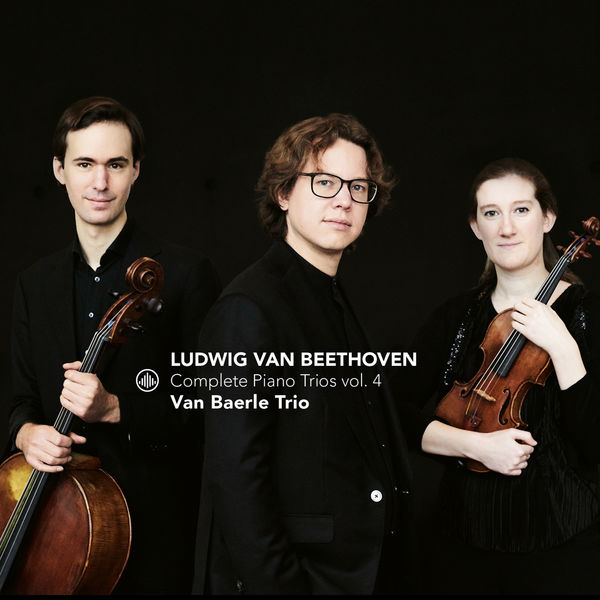
Streaming ilimitado
Escuche este álbum ahora en alta calidad en nuestras apps
Comenzar mi periodo de prueba gratis y escuchar este álbumDisfrute de este álbum en las apps Qobuz con sususcripción
SuscribirDisfrute de este álbum en las apps Qobuz con sususcripción
Idioma disponible: inglés
Beethoven’s most famous piano trio is dedicated to the Archduke Rudolph, himself an accomplished musician. The importance of Rudolph as a patron can be seen in the number of other prominent works that Beethoven dedicated to him. Beethoven started work on the trio in the second half of 1810, but much of the work was done in March of the next year. Some descriptions give an inkling of how novel a composition this was perceived to be, and a young Ignaz Moscheles reported: “In the case of how many compositions is the word ‘new’ misapplied! But never in Beethoven's, and least of all in this, which again is full of originality.”
A year after the Archduke, Beethoven wrote another piano trio in B-flat major. The autograph dates it 26 June 1812, but besides the similarity in key it is different in every way. It consists of a single movement, was not published during the composer’s lifetime, and was written to encourage the nine-year-old Maximiliane Brentano in her piano playing.
The Trio in E-flat WoO 38 might have been once intended to be part of Op. 1 and although there are no extant sketches to support this, the style of the composition makes a dating of around 1790-1 plausible. The trio contains some surprising twists and turns, particularly in its lengthy codas.
The last piece for piano trio that Beethoven published during his lifetime has one of the longest compositional histories of all of his works. It consists of a long introduction, followed by ten variations on ‘Ich bin der Schneider Kakadu’ from Wilhelm Müller’s popular opera Die Schwestern von Prag. The first version of this piece was probably composed between 1801 and 1803, but it was substantially revised in 1816, and most likely further revised before publication in 1824. This final trio therefore includes elements from Beethoven’s early, middle, and late styles. © Challenge Records
Está escuchando muestras.
Escuche más de 100 millones de pistas con un plan de streaming ilimitado.
Escuche esta playlist y más de 100 millones de pistas con nuestros planes de streaming ilimitado.
Desde $ 4.259,00/mes

Ludwig van Beethoven, Composer - Van Baerle Trio, MainArtist
(C) 2019 Challenge Classics (P) 2019 Challenge Classics
Ludwig van Beethoven, Composer - Van Baerle Trio, MainArtist
(C) 2019 Challenge Classics (P) 2019 Challenge Classics
Ludwig van Beethoven, Composer - Van Baerle Trio, MainArtist
(C) 2019 Challenge Classics (P) 2019 Challenge Classics
Ludwig van Beethoven, Composer - Van Baerle Trio, MainArtist
(C) 2019 Challenge Classics (P) 2019 Challenge Classics
Ludwig van Beethoven, Composer - Van Baerle Trio, MainArtist
(C) 2019 Challenge Classics (P) 2019 Challenge Classics
Ludwig van Beethoven, Composer - Van Baerle Trio, MainArtist
(C) 2019 Challenge Classics (P) 2019 Challenge Classics
Ludwig van Beethoven, Composer - Van Baerle Trio, MainArtist
(C) 2019 Challenge Classics (P) 2019 Challenge Classics
Ludwig van Beethoven, Composer - Van Baerle Trio, MainArtist
(C) 2019 Challenge Classics (P) 2019 Challenge Classics
Ludwig van Beethoven, Composer - Van Baerle Trio, MainArtist
(C) 2019 Challenge Classics (P) 2019 Challenge Classics
Presentación del Álbum
Beethoven’s most famous piano trio is dedicated to the Archduke Rudolph, himself an accomplished musician. The importance of Rudolph as a patron can be seen in the number of other prominent works that Beethoven dedicated to him. Beethoven started work on the trio in the second half of 1810, but much of the work was done in March of the next year. Some descriptions give an inkling of how novel a composition this was perceived to be, and a young Ignaz Moscheles reported: “In the case of how many compositions is the word ‘new’ misapplied! But never in Beethoven's, and least of all in this, which again is full of originality.”
A year after the Archduke, Beethoven wrote another piano trio in B-flat major. The autograph dates it 26 June 1812, but besides the similarity in key it is different in every way. It consists of a single movement, was not published during the composer’s lifetime, and was written to encourage the nine-year-old Maximiliane Brentano in her piano playing.
The Trio in E-flat WoO 38 might have been once intended to be part of Op. 1 and although there are no extant sketches to support this, the style of the composition makes a dating of around 1790-1 plausible. The trio contains some surprising twists and turns, particularly in its lengthy codas.
The last piece for piano trio that Beethoven published during his lifetime has one of the longest compositional histories of all of his works. It consists of a long introduction, followed by ten variations on ‘Ich bin der Schneider Kakadu’ from Wilhelm Müller’s popular opera Die Schwestern von Prag. The first version of this piece was probably composed between 1801 and 1803, but it was substantially revised in 1816, and most likely further revised before publication in 1824. This final trio therefore includes elements from Beethoven’s early, middle, and late styles. © Challenge Records
Acerca del álbum
- 1 disco(s) - 9 pista(s)
- Duración total: 01:18:46
- 1 Libreto digital
- Artistas principales: Van Baerle Trio
- Compositor: Ludwig van Beethoven
- Sello: Challenge Classics
- Género Clásica
(C) 2019 Challenge Classics (P) 2019 Challenge Classics
Mejorar la información del álbum
